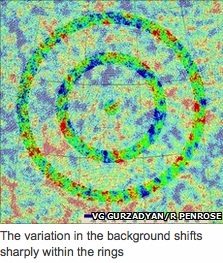This is nifty (h/t Gardner Dozois). Cosmologist Roger Penrose and his associate Vahe Gurzadyan have found concentric rings in the sky, deep in space, which scientists believe are shockwaves arising from the collision of supermassive, galactic black holes in the far distant past.
 The currently accepted model of the universe* posits that it started as an infinitely dense point of unimaginably high energy. The early universe expanded much faster than the speed of light, till matter and energy condensed out of their prior entangled state, in a phase known as inflation. This rapid expansion would necessarily have obliterated these rings. Penrose’s model, Conformal cyclic cosmology (CCC), apparently predicts the rings, which suggest that the universe pre-dates the Big Bang—that is, that there was no theoretical beginning to the universe—and thus challenges the standard model, including inflation.
The currently accepted model of the universe* posits that it started as an infinitely dense point of unimaginably high energy. The early universe expanded much faster than the speed of light, till matter and energy condensed out of their prior entangled state, in a phase known as inflation. This rapid expansion would necessarily have obliterated these rings. Penrose’s model, Conformal cyclic cosmology (CCC), apparently predicts the rings, which suggest that the universe pre-dates the Big Bang—that is, that there was no theoretical beginning to the universe—and thus challenges the standard model, including inflation.
The findings are still preliminary, and a lot more research would need to be done to unseat the currently accepted inflationary model as an explanation for how our universe got to be where it is today. Still, it’s fascinating stuff. If true, it would not only change our understanding of the past, but also our expectation of future events.
Two things intrigue me about this. First, I am fascinated by how the ancient past is etched into the fabric of space. Second, I am impressed as hell that researchers whose only medium of study is the trickle of light emitted long ago by distant suns can extract so much knowledge from it. Here’s to the genius that can tease free such magnificent concoctions—such spires and castles and landscapes of thought—sipping info through such tiny straws.
__________________________
*Obligatory cautionary note: layperson’s interpretation here. Apply due salt shakings.





